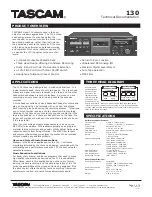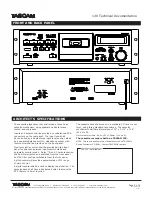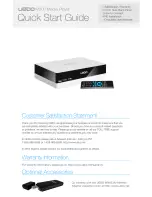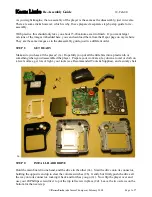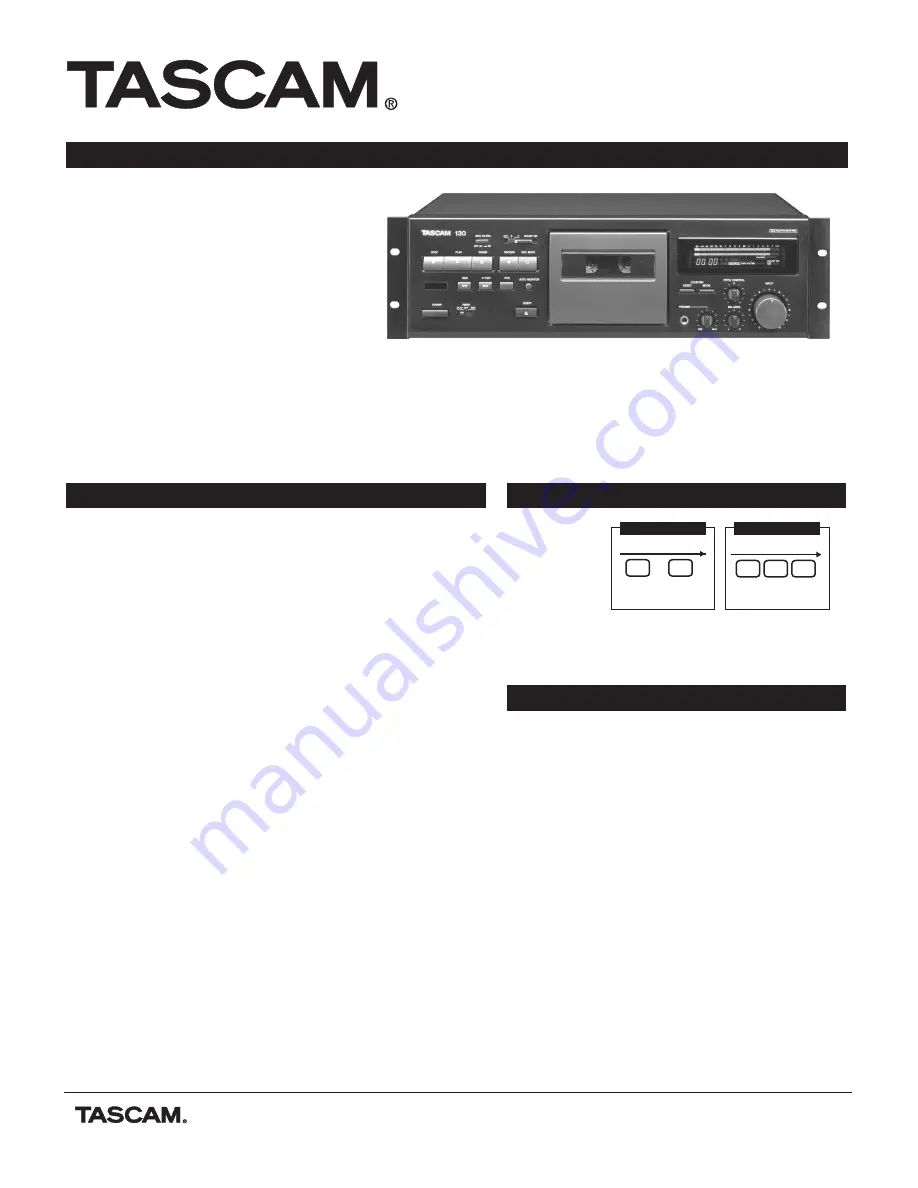
Technical Documentation
130
TASCAM's Model 130 cassette deck is the best
value for mixdown applications. The 130's three
head design places the play head after the
record head, so you can monitor the sound from
tape during mixdown, rather than just listen to
the audio being sent to the recorder. Of course,
with high sonic performance, detailed metering,
and complete list of noise reduction options, it's
no wonder the 130 is popular with users of all
levels.
7733 Telegraph Road • Montebello, CA 90640 • (323) 726-0303 • http://www.tascam.com
All features and specifications are subject to change without notice. Contact your local TASCAM representative for the latest information.
The 130's three head design is key in mixdown situations. In a
typical cassette deck, there are only two heads. The erase head
erases any signal previously recorded to the tape, and the other
head switches between record or playback. So, when you are
recording, you only know what is being sent to the cassette
recorder.
A three head cassette deck has independant heads for record and
play, so the signal can be recorded with one head, and played
back from the play head during the recording process. This allows
you to listen to what is going onto the cassette while recording.
Listening to the tape as you record lets you know instantly if the
tape is overloading, or if there are bad sections on the tape. No
longer will you have to wait until the whole tape is done to know
if the tape is OK!
Also, if any recordings of radio broadcasts are to be done, the
MPX Filter is invaluable. FM broadcasts actually carry program
material that can interfere and possibly totally defeat Dolby noise
reduction circuits from being effective. The MPX Filter targets
and removes these frequencies from the content to be recorded
without creating any audible artifacts.
Home and Project Studio Mixdown Deck
Mixdown is the obvious application for the 130. Confidence
monitoring afforded by the three head design, combined with the
outstanding sonic performance make the 130 the best value for
cassette recorders.
Music Education Installations
For band, choir, drama, and dance programs that need to make
high quality rehearsal and show tapes, the 130 is unbeatable.
Often times, users in this application do not have any formal
training in audio recording, and the simple operation of the 130
limits the possibilities of the wrong button being engaged. Plus,
the pitch control offers the ability to make anything from minor
adjustments to pitch, or drastic tempo adjustments easily.
Page 1 of 2
130_TECHDOC.pdf
032500
• 3-U Rack Mountable Cassette Deck
• Three Head Design Offering Confidence Monitoring
• Dolby B and C with HX Pro Headroom Extention
• ±10% Pitch Control with Clear On/Off Switch
• Headphone Output with Level Control
• Return To Zero Function
• Unbalanced RCA Analog I/O
• Precision Digital Level Meters
• Auto Tape Selection
• MPX Filter
PRODUCT OVERVIEW
APPLICATIONS
THREE HEAD DIAGRAM
Performance Specifications:
Track System:
Heads:
Type of Tape:
Tape Speed:
Fast Wind Time:
Pitch Control:
Motors:
Frequency Response:
Signal to Noise Ratio:
Wow and Flutter:
Line RCA Input:
Line RCA Output :
Headphone Output:
General Specifications:
Power Requirements:
Power Consumption:
Dimensions:
Weight:
4 track, 2 channel stereo
(1) Erase, (1) Record, (1) Reproduce
Cassette C-60, C-90
1 7/8 ips, 4.76 cm/sec
Approximately 90 seconds for C60
Approx ±10%
1 DC servo motor for capstan
1 DC reel motor
15Hz-21kHz ±3dB Metal
15Hz-20kHz ±3dB CrO2
15Hz-18kHz ±3dB Normal
>80dB Dolby C, CCIR-ARM
>70dB Dolby B, CCIR-ARM
>58dB Dolby off, at reference level
<0.04% (W RMS)
-10dBu, 97mV, 50k Ohms
-10dBu, .58hV, <50k Ohms
1mW, 8 Ohms
Switchable:
120V AC, 60Hz (US/Canada Model)
230V AC, 50Hz (Europe Model)
15W
482 x 132 x 290 mm
19" x 5 1/4" x 11.4"
5.0Kg, 11.02 lbs.
As explained in
the Applications
Section of this
document, the
typical cassette
recorder only has
two heads, with
one head doubling
as play and record. When you monitor a two head tape deck during
record, all you hear is what you are sending it. In a three head design,
the play head is totally independant of the record head, allowing you to
listen to the sound from tape.
SPECIFICATIONS
Erase
Head
Record/Play
Head
Tape Path
2 Head System
Erase
Head
Record
Head
Tape Path
Play
Head
3 Head System

